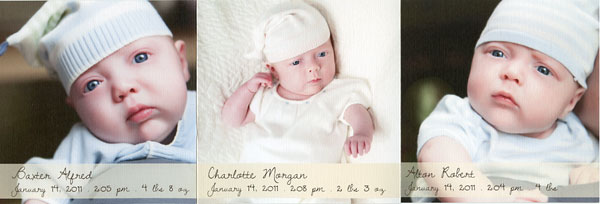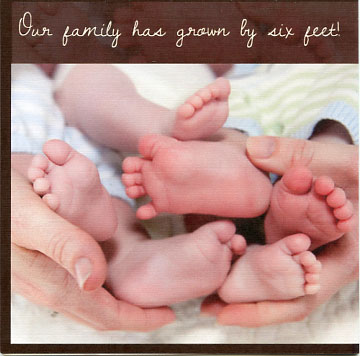
Kreg Jones, well actually his wife, recently had triplets using in vitro fertilization (IVF). While there are a number of assissted reproductive technologies (ART) available to couples, in vitro fertilization (IVF) is by far the most utilized of these methods. In fact, IVF accounts for more than 95% of all ART procedures.
The following article is by Erica Lamberg
Are you expecting more than one baby? You’re not alone – births of twins, triplets and more are becoming increasingly common. Here, find out some of the reasons for the multiple baby boom, how some twin pregnancies are diagnosed, and some resources where you can find support and more information.
The new statistics
Multiple births are on the rise. According to the Centers for Disease Control (CDC), between 1980 and 1997, the number of twin births rose 52 percent, while triplet and other higher order multiple births (heretofore (triplets, quadruplets or greater) jumped by 404 percent. Over the same period of time, singleton births rose a mere 6 percent.

This multiple baby boom is believed to be due to two major trends: the fact that more women are delaying motherhood until their mid to late thirties (the likelihood of a woman experiencing a multiple pregnancy increases until age 40); and the increased use of fertility treatments.
According to Frank Craparo, M.D., a Perinatalogist (high risk OB/GYN) with Abington Perinatal Associates of Abington Memorial Hospital in Abington, “Women in their mid to late 30s have been known to release more than one egg during a monthly ovulation cycle. In most cases, this would lead to a single birth. But, in a small number of cases, it leads to multiple births.”
The impact of fertility treatments Moreover, today’s medical technology can include advanced fertility drugs, which can multiply the number of eggs released each month, or procedures such as in vitro fertilization, where multiple fertilized eggs are placed in a woman’s uterus. “Normally during a woman’s cycle, only one egg gets released. If ovulation stimulation medication is used, more than one egg may become fertilized,” explains Dr Craparo.
Similarly, in vitro fertilization (IVF) is also an option for couples. IVF involves taking eggs from the woman, fertilizing them in the laboratory with her partner’s sperm and transferring the resulting embryos back to her uterus 2-6 days later. “To increase the success rate of the procedure, multiple eggs are usually implanted in the woman,” says Dr Craparo.
Types of twinning
The vast majority of multiple births — 95 percent — continue to be twins. Twins occur naturally in about 1 of every 90 births, and triplets occur naturally in only 1 of every 10,000 births. Both are becoming more common with fertility treatments.
Fraternal twins, which occur when two separate eggs are fertilized, are the more common type of twins, representing about two thirds of all twin births in the United States. Your chances of having fraternal twins appear to increase with your age and the number of children you have. In addition, your chance of having a multiple birth also increases if fraternal twins run in your family. Identical twins, formed when a single fertilized egg divides into two fetuses, are more rare and represent less than one percent of all births.
Taking good care
Your doctor may suspect a multiple pregnancy when more than one fetal heartbeat is heard. According to Dr Craparo, “Other factors that might signal a multiple pregnancy include: the uterus grows more quickly than normal; excessive nausea and vomiting are present in the first trimester; or you may feel more fetal movement than you did in previous pregnancies.”
Early diagnosis is key to the health of mother and babies. If you have a multiple pregnancy, you need to take extra precautions including increased doctor visits and testing to monitor the growth of each fetus. In addition, your doctor might also prescribe additional iron and vitamin supplements and urge you to reduce physical activity. Furthermore, Dr Craparo explains that multiple and other high risk pregnancies include detailed, targeted ultrasounds at 4 week intervals and a non-stress test to monitor the babies.
“Although medical technology has improved greatly, carrying multiples is still considered high risk,” says Bruce Young, M.D., a Perinatalogist and director of maternal and fetal medicine with New York University Medical Center in New York City. If mother or fetuses experience serious complications early in the pregnancy, doctors may recommend a procedure called multi-fetal reduction of pregnancy. In this controversial procedure, a lethal chemical is injected into one or more of the fetuses, giving the others a greater chance for survival. “This procedure is generally done the first trimester and is not recommended for women carrying less than three fetuses. There is additional 5 to 10 percent risk of miscarrying the remaining fetuses,” says Dr Young.
Complications and considerations of pregnancy and birth Dr Young suggests women who are carrying multiples be properly nourished and get adequate rest during their pregnancy. “It’s not uncommon for a period of bed rest to be prescribed beginning around the 24th week of pregnancy,” he points out. He futher explains other medical problems for women carrying multiples may include gestational diabetes, toxemia, high blood pressure and anemia.
Medical experts acknowledge that the risk of complications such as premature birth or a low birth weight are higher with a multiple pregnancy. “Premature labor and delivery is a definite concern for a woman carrying multiples. Early enlargement of the uterus puts the woman at risk for pre-term delivery which may cause subsequent health risks to the babies.” says Dr Craparo.
Premature delivery increases the chance of non-survival and other health problems. “The greatest concern for a premature infant is that their lungs are not ready to breathe on their own and they usually are on a respirator,” adds Dr Craparo. Furthermore, fifty percent of twins and ninety percent of high-order multiples weigh less than 5-1/2 pounds at birth, compared with 5 percent of singleton babies.
Although it is possible for twins to be delivered vaginally, Dr Craparo estimates that, “Ninety-nine percent of triplets and higher multiples are delivered via cesarean section.”
Double, triple the work Unlike a family with two or three children who were born a few years apart, parents of multiples are faced with buying triple (or more) the diapers, formula, and baby food all at once. This can add up to hundreds of extra dollars a month. Doctors’ costs would also be higher, since infants visit the pedriatrician often during the first year. In addition, because multiples are often a couple’s first children, there isn’t the benefit of hand-me down clothes, high chairs, swings, car seats and other baby necessities.
“Parents of multiples have to overcome any resistance they may feel about asking for help,” says Janet Bleyl, President of The Tripet Connection, a non-profit organization for multiple birth families which provides information, encoragement, resources and networking to families who are expecting triplets or more. “The Triplet Connection has become a lifeline to expectant parents, and a great resource to parents of larger multiples,” she adds.
Finding support Kimberly Worrell of Northeast Philadelphia gave birth to quadruplets in May 1997 and is a member of The Triplet Connection. Mrs Worrell delivered four babies at 26 weeks, but one son died a week after birth due to serious medical complications. “With my three surviving quads, I feel blessed,” she says. Mrs Worrell was on fertility medication when she conceived her quads, and knew at 5 weeks she was carrying multiples.
Today, the Worrells have 3 healthy, active toddlers and Mrs Worrell says things are beginning to get a bit easier. “Now that they sleep through the night and they are on a schedule, things are manageable. I am fortunate that I get help from my mother and mother-in-law who watch them while I work from home.”
She offers some advice to couples who may be the parent of multiples: “When a woman begins taking fertility drugs, she should know the risks and feel comfortable with her doctor,” she insists. She also suggests contacting baby product companies for some free merchandise. “We got coupons for free baby food from Gerber and free diapers from Pampers.” Furthermore, she describes that The Triplet Connection has an expectant parent packet with tips and resources for parents, and publishes a newsletter for parents as well. Additional information regarding The Triplet Connection may be obtained from their website, www.tripletconnection.org.
By speaking with other mothers and fathers of multiples who have “been there,” they can share their experiences, and their advice may make the arrival of your twins, triplets, quadruplets or others a manageable addition to the family.
Source: http://pregnancyandbaby.sheknows.com/pregnancy/baby/Baby-boom–Expecting-twins-triplets-or-more-5580.htm






























